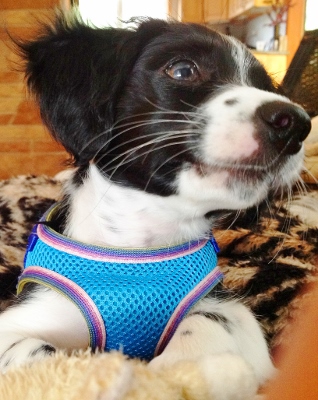
Seattle veterinarian Dr. Robin E. Riedinger explores the potential dangers of an overbite for your puppy.
Enzo is the Hawthorne Hills Veterinary Hospital Pet of the Month for May. Everyone knows that puppies need vaccines to keep them healthy and protected from diseases. However, it can be easy to underestimate the benefits of thorough and regular examinations when puppies are growing into adulthood. Every breed has special characteristics that make them unique and add to their appeal and sometimes there are physical changes that need to be addressed quickly. For this reason our veterinarians believe in examinations with every vaccine, especially during a puppy’s formative months.
Enzo is a short-haired Havanese and he was born with his lower jaw shorter than the upper jaw. This is called an Overbite, also referred to as an Overshot Jaw, a Parrot Mouth or Mandibular Brachygnathism. This malocclusion is a genetic change and can be seen in a number of breeds, oftentimes collie related breeds and dachshunds. Occasionally this change happens because of differences in the growth of the upper and lower jaws, and in many cases it doesn’t cause any significant problems other than cosmetically.
Dr. Robin Riedinger evaluated Enzo at his first visit when he was just 11 weeks of age and while the lower jaw was too short, there was no evidence of damage and no indication that this was causing a problem for Enzo. When there is abnormal occlusion of the teeth, it is important to monitor closely for trouble caused by the teeth being aligned improperly. Malocclusions can lead to gum injuries, puncturing of the hard palate, abnormal positioning of adjacent teeth, abnormal wear and bruising of the teeth, permanent damage and subsequent death of one or more teeth, and in the long run, premature loss of teeth. Some malocclusions can be severe enough to interfere with normal eating and drinking.
Within three weeks, when Enzo was only 3.5 months old, it was clear that our doctors would need to intervene. The left and right sides of Enzo’s upper jaw (maxilla) were growing at different rates because the lower canine teeth were being trapped by the upper canine teeth. This is called Dental Interlock. Because the teeth are ‘locked’ in place, the lower jaw cannot grow symmetrically and this creates a number of other problems. Early intervention is critical.
Here are pictures of the changes Dr. Riedinger was seeing in Enzo’s mouth.
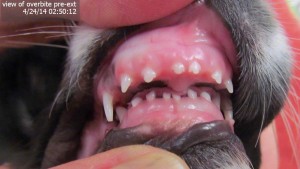 1.) View showing the overbite – the upper jaw is significantly longer than the lower jaw.
1.) View showing the overbite – the upper jaw is significantly longer than the lower jaw.
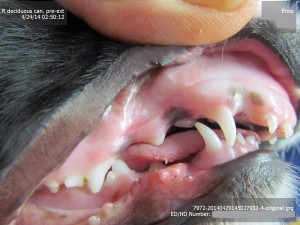 2.) View showing the right side lower canine tooth behind the upper canine tooth.
2.) View showing the right side lower canine tooth behind the upper canine tooth.
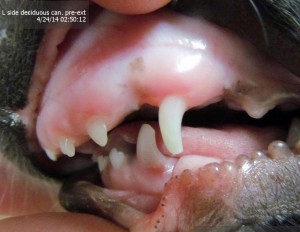 3.) View showing the left side lower canine tooth in front of the upper canine tooth.
3.) View showing the left side lower canine tooth in front of the upper canine tooth.
The solution for Dental Interlock is to extract the teeth from the shorter jaw; in this case, the lower ‘baby’ canines and thereby allow the lower jaw (mandible) to grow in the best way possible. This procedure is most effective when the Dental Interlock is discovered early and the extractions are performed quickly. In some cases, this can be as early as ten weeks of age. Dr. Riedinger consulted with a local veterinary dental specialist to confirm the treatment plan and to get advice on extracting the deciduous teeth without damaging the developing adult canines. Dental radiographs are essential to proper extraction technique and also to ensure that there are no other abnormalities below the gumline.
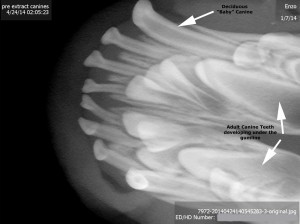 This dental x-ray image shows the deciduous teeth, and the second row of developing adult teeth within the jaw just below the gumline.
This dental x-ray image shows the deciduous teeth, and the second row of developing adult teeth within the jaw just below the gumline.
This picture shows the ‘baby’ or deciduous teeth after extraction.
You can see how long the roots of the deciduous ‘baby’ teeth are. During normal growth, the body will begin to resorb the roots, making them loose, and allow them to fall out as the adult tooth begins to emerge. When we need to remove the deciduous teeth before they are loose, it can be quite tricky to remove the tooth carefully without breaking it and without injuring the adjacent teeth.
Once extracted, each deciduous canine tooth was about 2 centimeters long; the roots were about 1.5 centimeters. Many people are surprised to learn that the root of a dog’s tooth is so large – 2/3 to 3/4 of the tooth is below the gumline. This is one reason why it is so important to use radiographs to evaluate teeth on a regular basis, not just in a growing puppy. Adult teeth can, and frequently do, have problems that are only visible with a radiograph.
Enzo came through his procedure extremely well. He was given pain medications for comfort and had to eat canned foods and avoid chewing on his toys for the next two weeks to ensure that the gum tissue healed properly. As he continues to grow we will be monitoring how his jaw develops and Dr. Riedinger will also be watching the alignment of his adult canine teeth when they start to emerge around six months of age. Hopefully this early intervention will minimize problems for Enzo in the future.
Links for additional information about some dental issues:
- Article with an overview of alignment issues written by Jan Bellows, DVM, DiplAVDC (veterinary dental specialist):
- Information from the American Veterinary Dental College:


 6512 12th Ave NE
6512 12th Ave NE
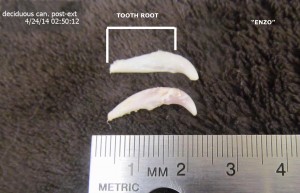




We’re looking into having the same procedure for our labrador puppy, who is currently 7 weeks old. Did Enzo’s jaw develop normally after the procedure? Did you have to cap/adjust the adult teeth? Either way, we send Enzo our best wishes for health and comfort 🙂
Thank you for replying to our post. These are situations where is it is so important to seek the best care with your pet’s primary veterinarian since every circumstance is different. Since you asked, here is the follow-up with Enzo.
I am Enzo’s mother (Sara) and I work here at Hawthorne Hills Veterinary Hospital.
Enzo’s jaw did develop normally although he did develop an issue with adult lower canines starting to create some trauma to the upper palate because of their length and placement. When he was about 10 months old he went to the dental specialist to have an odontoplasty (surgical contouring of tooth surface to shorten his teeth) so that they would not hit the roof of his mouth. Luckily, he had very shorter roots and the dental specialist was able to shave down his teeth without hitting the root structure inside. Now annually we do dental x-rays to ensure that the roots have remained healthy.
It was a bit of a long road to correct his little puppy teeth but now he is 2 years old and we do not regret putting his health first and making sure he gets the best start to his wonderful life. We would do anything for this little love bug.
We may be looking to attending to a similar situation with our puppy. Do you have pics of Enzo’s final outcome. The pics are so helpful. What sort of cost could one expect for the initial dental work (not including the adult work).?
Sara, thank you so much for your reply! I’m so happy that Enzo is doing so well. I’ve thought about him from time to time — I left my comment here and forgot to bookmark the page (duh) to check back — I finally did some digging through my browser history to find it. We ended up doing the same thing for our puppy Echo — extraction of the puppy teeth, and then when the adult teeth came in, the crown amputation for her canines and the odontoplasty for the lower incisors. She’s only 6 months old but she was already getting trauma in the upper palate -We’ll do the dental x-rays annually as well. I’m so glad that Enzo is able to have a comfortable mouth! Echo is very happy and back to normal activities. She’s adjusting well to her lifelong ban on tennis balls and chewing on hard things. She’s loving her new Zogoflex toys from West Paw, and the Himalayan folks recently released the “yakyChurro” which is a softer version of their Yak Milk Bones that Echo loves so much. I’ve ordered the churros from a reseller on eBay (after calling the Himalayan company to make sure it was a legit reseller) and we’ll have them next week. Thanks again for sharing Enzo’s experience with us and give him a hug for us!
Thank you both so much for sharing your experiences. We are about to embark on the same journey with our sweet Bernese Mountain Dog Chloe. She is 13 weeks and will be having the same surgery done in about a week and I’m hoping to have as good of an outcome as you both have had. We have been so worried for her as her baby teeth have already begun to impact her upper palate. As luck would have it we have a board certified animal dental specialist only 10 minutes away so we were able get her right in.
I’m curious as to where to find the Zogoflex toys and yakyChurros??? Any tips on what to do or not do after we bring her home?
If you extract the two bottom teeth to correct this, will the dogs tongue always hang out?
The tongue doesn’t hang out if it is only the deciduous (baby) teeth that are extracted. Once the adult teeth come in, they help to hold the tongue in position. Ultimately, it is more important to have a comfortable and normal alignment of the teeth.
We are due to pick up our 8 week old Havenese and the breeder informed us of a 1/4 inch overbite. Is this something we should be concerned about? Just trying to access the financial commitment before we have not recourse.
Not all issues create a long term problem. We can’t give medical advice, so to get the best answers you’ll need to discuss with your puppy’s veterinarian.
As a new puppy mom whose breeder did NOT disclose anything to us, our cost to have his lower canines removed was $1500 and we are waiting until he turns 6 months to find out what happens next. Looking back I wish I would have known so we could have made an informed decision!! BUT, we love our little guy so much, so it’s hard to know what we would have done.
Teeth change as a puppy grows, and some problems aren’t always noticeable at an early age. This is why we advocate for regular exams by a veterinarian every 3-4 weeks while your pet is also getting his or her vaccinations. Early diagnosis can sometimes offer more options.
Thank you to everyone who has posted on here, and it is such a happy story to hear how Enzo is doing. We just picked up an 8 week old doodle and the breeder also didn’t disclose our puppy’s overshot jawline until we were doing the hand off in a town we each drove to from our respective homes. She also underplayed the severity of the malocclusion, and we got a funny feeling and took her straight to the vet. We are now faced with the difficult decision of keeping her in all of her orthodontic glory, or returning her to the breeder. These stories have given me hope that early intervention may help her to have a happy and healthy life with us, although it will be expensive. These stories shine such a bad light on the dog breeding industry and make for a stressful start to our adventures with our companions 🙁